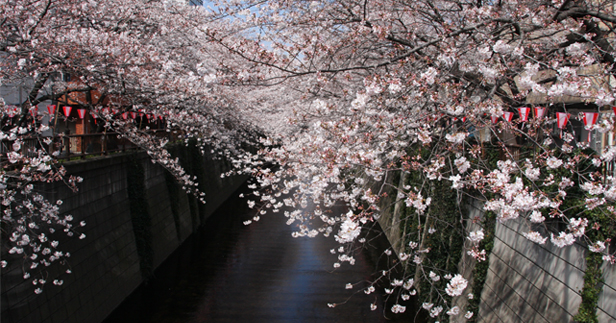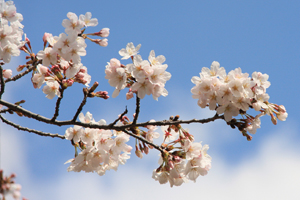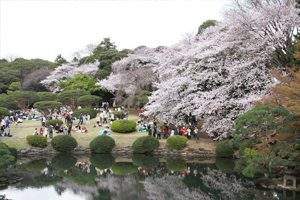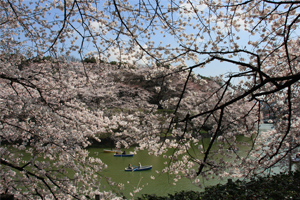The Weekender Guide to Sakura Season
By Vivian Morelli
It’s April again and millions of gorgeous, ephemeral sakura flowers are in bloom. Grab a blanket, a few drinks and snacks and gather with friends and family under the cherry trees for the happiest, most lighthearted, and undoubtedly most beautiful time of the year: o-hanami. Just make sure you turn up early, as Japanese salarymen are known to stake out prime park real estate for hours to secure a good spot. The following are Weekender’s pick of Tokyo’s top hanami spots. Enjoy!
Daikanyama Saigoyama Koen
Just one stop from Shibuya, amidst the hilly and trendy streets of Daikanyama, is the gorgeous and quiet Saigoyama Koen. This mid-sized park not only is a prime spot for cherry blossom viewing but also offers an exclusive peek at the surrounding city with its wide open skies and street proximity.
Closest station: Daikanyama (Toyoko line)
Yoyogi Park
Renowned Yoyogi Park, a favorite amongst Tokyoites and visitors alike, needs no introduction. Adjacent to Harajuku station, it offers an easy escape from the busy shopping streets and its spacious, grassy grounds are perfect for endless hours of frolicking and relaxing. Nearby Meiji Shrine offers a nice distraction if you feel like wandering about.
Closest station: Harajuku (JR line)
Shinjuku Gyoen
Originally a residence of the Naito family in the Edo era, the beautiful gardens blend three distinct styles: French Formal, English Landscape and Japanese traditional. Shinjuku Gyoen is one of the most popular sites for hanami as it presents a variety of trees, so get there early to grab a spot, and don’t forget that alcohol isn’t allowed at this particular park. Don’t miss the traditional tea house for a full cultural experience.
Closest stations: Shinjuku, New South Exit (JR line) Sendagaya (JR line) / Shinjukugyoenmae (Marunouchi subway line)
Ueno Park
One of the country’s first public parks, Ueno is now Japan’s most popular city park. Its cherry blossom trees are the largest in the city, therefore making Ueno one of the best places to view the blooming flowers. Other interesting features of the park include a lake, lotus bed and marshland, rendering it a great location for an outdoorsy afternoon.
Closest station: Ueno (JR line)
Inokashira Koen
A little removed from central Tokyo, Inokashira Koen still offers incredible views of sakura. Located in the charming neighboring streets of Kichijoji, the park presents a nice lake surrounded with cherry trees and inviting grounds for a picnic but be warned, Inokashira Park is very popular so expect hundreds of visitors.
Closest station: Kichijoji (Keio Inokashira and JR lines)
Meguro River
The Meguro River offers some of the most beautiful cherry blossoms. Walk along the river to view the flowers, as well as to enjoy the quiet shopping area, and take a small break on a park bench or small grassy spot to indulge in some drinks and snacks amidst the city vibe.
Closest station: Nakameguro (Toyoko line)
Mitsuike
Mitsuike Koen, located near Yokohama, is very small but has one of the largest varieties of cherry trees, a pleasing fact for sakura aficionados. The park also has three small ponds, around which over a thousand cherry trees are planted.
Closest station: Tsurumi (JR line)
Aoyama Graveyard
Although it may not be everyone’s cup of tea to hold hanami in a cemetery, Aoyama-bochi has some of the most beautiful and widest variety of cherry trees in Tokyo, which line the straight roads that run through the cemetery. Perhaps for The Smiths fans only and those who dread sunny days.
Closest station: Gaienmae (Ginza subway line)
Hamarikyu Garden
Situated at the mouth of Sumida River, Hamarikyu is a traditional Japanese garden, complete with a pond, peony garden, plum tree grove and a tea house that offers green tea and sweets. The garden is usually quiet and is a lovely spot for a leisurely picnic.
Closest station: Shimbashi (JR line)
Hanami Essentials
• Blue plastic tarps and aluminum-like ones are readily available and practical.
• Blanket, which also provides warmth for those chilly early days of spring.
• Simple snacks such as onigiri and sembei.
• Bento box for Japanese style, or baguette and cheese for Western style.
• Bottles of green tea and water.
• The quintessential cans of beers, chu-hi, sake, or perhaps a bottle of wine (or three).
• Homemade white sangria: mix some chilled white wine and wedges of apples, oranges, and citrus.
• Sweets: try the traditional mitarashi (skewered sweet dumplings).












